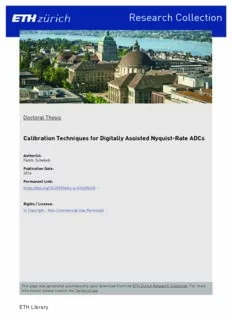
Calibration Techniques for Digitally Assisted Nyquist-Rate ADCs PDF
Preview Calibration Techniques for Digitally Assisted Nyquist-Rate ADCs
ETH Library Calibration Techniques for Digitally Assisted Nyquist-Rate ADCs Doctoral Thesis Author(s): Fateh, Schekeb Publication date: 2016 Permanent link: https://doi.org/10.3929/ethz-a-010655420 Rights / license: In Copyright - Non-Commercial Use Permitted This page was generated automatically upon download from the ETH Zurich Research Collection. For more information, please consult the Terms of use. Calibration Techniques for Digitally Assisted Nyquist-Rate ADCs DISS. ETH NO. 23227 Calibration Techniques for Digitally Assisted Nyquist-Rate ADCs A thesis submitted to attain the degree of DOCTOR OF SCIENCES of ETH ZURICH (Dr. sc. ETH Zurich) presented by SCHEKEB FATEH MSc ETH EEIT born on April 23rd, 1983 citizen of Biel/Bienne BE, Switzerland accepted on the recommendation of Prof. Dr. Qiuting Huang, examiner Prof. Dr. Christoph Studer, co-examiner 2016 Dedicated to my family. “The garden of the world has no limits, except in your mind.” Rumi Acknowledgements First of all, I would like to express my gratitude to my advisor, Prof. Dr. Q. Huang. His continuous support, intelligent guidance, stimulating discussions, and patience throughout the course of this challenging research were invaluable to the work presented in this thesis, and I am very grateful to him for providing an outstanding research environment at the Integrated Systems Laboratory (IIS). At the same time, I would like to express my gratitude to my co- advisor, Prof. Dr. C. Studer, who kindly agreed to act as an external co-examiner of my dissertation. His interest in my work and his comments during our discussions led to numerous improvements of this thesis. MyveryspecialthanksgotoProf.Dr.L.Benini,Prof.Dr.A.Burg, and Prof. Dr. H. Kaeslin for numerous fruitful discussions. I owe special thanks to Dr. J. Treichler, P. Sch¨onle, G. Rovere, M. Safi, M. Rashid, and Dr. T. Burger for proofreading this thesis. Many thanks also go to my former colleagues at work, in particu- lar R. Blattmann, Dr. C. Benkeser, Dr. T. Christen, Dr. Y. Chen, Dr. P. Greisen, C. Keogh, Dr. P. Meinerzhagen, Dr. C. Martelli, Dr. D. Seethaler, F. Schulthess, Dr. C. Senning, and R. Ulrich. Special thanks also go to Advanced Circuit Pursuit (ACP) for prototyping the ASICs being essential for my research. This includes mycolleaguesworkingthere,inparticularDr.F.Bu¨rgin,Dr.J.Chen, Dr. Y. Chen, Dr. T. Dellsperger, Dr. I. Kouchev, D. Riha, Dr. J. Ro- gin, and Dr. D. Tschopp. Moreover, I would like to thank the staff members of the IIS and the Design Zentrum (DZ), namely A. Feigin, C. Wicki, H. Gisler, F. Kunz, N. Felber, F. Gu¨rkaynak, and B. Muheim, for the excellent vii viii ACKNOWLEDGEMENTS maintenance of the infrastructure. Special thanks also go to M. Lanz for bonding my ASICs. Many thanks also go to my present colleagues of the Analog and Mixed-Signal and the Digital Circuits and Systems Design Groups for their friendship and support, in particular L. Bettini, S. Belfanti, P. Bunjaku, X. Han, T. Kleier, H. Kr¨oll, D. Luu, L. Wu, C. Roth, B. Sporrer, S. Altorfer, B. Weber, D. Bellasi, M. Gautschi, C. Keller, M. Schaffner, M. Mu¨hlberghuber, P. Vogel, P. Hager, Dr. A. Bar- tolini, L. Cavigelli, Dr. A. Magno, Dr. A. Marongiu, A. Pullini, and D. Palossi. I owe special thanks to C. Haller, E. Plank, A. Bakanova, B. Malesevic, and F. Heitz for the administrative work during my time at IIS. Moreover,IwouldliketothankmycolleaguesoftheMicrelLabat the university of Bologna, in particular S. Benatti, F. Casamassima, Dr. B. Milosovic, M. Tomasini, and Dr. E. Farella. It is also my pleasure to express my thanks to my colleagues and friends, specially E. Auger, C. Sidler, N. H¨auptli, S. Serov, A. Gu¨zel, P. Lu¨thi, J. Biveroni, K. Sartori, J. Ong, D. Juric, A. Di Carlo, A.Kyburz,W.Liu,A.Barresi,andA.Zuberbu¨hler,forallthesupport and unforgettable discussions. In addition, I would like to express my gratitude to my family for supporting my studies and encouraging me to pursue this career. Manythankstomyparentsandmysiblingsforalltheirhelp. Special thanksgoalsotomyfamilylivingintheNetherlandsforalltheirsup- port. Inparticular,Ialsoowemanythankstomywifeforthesupport andmotivationalongthisjourney. Iwouldliketodedicatethisthesis tomyfamilyfortheirlove,patience,support,andunderstandingsince they allowed me to spend most of the time on this thesis. In addition, I would like to express my gratitude to B. Steiger, E. Fu¨ger, C. Amstutz, H. Sahli, C. Koch, and A. Mastantuoni for all their help and support in my past. Finally, I appreciate the contributions to my research from the following students: N. Agianniotis, and C. Zhang. I would like to express my gratitude also to the students working part-time in the analogLab,inparticularD.Burri,N.Brun,F.Glaser,andF.Huang. They allowed me to concentrate on my research while taking over my other duties at the IIS. ix This project has been partially funded by Nano-Tera.ch, which is financed by the Swiss Confederation and scientifically evaluated by Swiss National Science Foundation (SNSF). Zurich, May 23, 2016 Schekeb Fateh
Description: